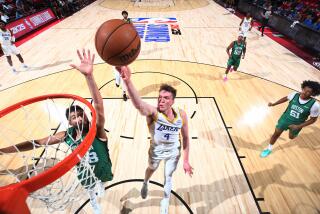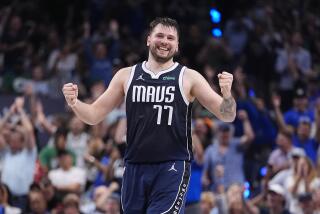KG’s top movie? ‘Jumper’
- Share via
It’s a look that Boston’s Kevin Garnett is certain to see against the Lakers when he has the ball away from the basket in Game 4 of the NBA Finals.
Instead of being crowded by multiple defenders, Garnett will find himself with plenty of inviting space to shoot.
Normally, the best move would be to take the shot, but not for Garnett.
The Celtics’ athletic and versatile 6-foot-11 big man can be more effective if he attacked the rim.
Just imagine the problems Lakers center Pau Gasol would have if Garnett drove to the basket without hesitation every time he touched the ball.
With Boston holding a 2-1 lead in the best-of-seven series, Garnett has proven to be a force in averaging 18 points, 13 rebounds and nearly four assists a game.
But there have been times when Garnett has hurt himself with too many perimeter shots. That surely was the case in the Lakers’ 87-81 victory over the Celtics in Game 3 on Tuesday.
Garnett took a game-high 21 shots (Kobe Bryant had 20 attempts in scoring 36 points for the Lakers) but finished with only 13 points as he struggled to make one jump shot after another.
Jump shots are definitely wrong for Garnett, who creates fear in defenders when he’s aggressive offensively.
In Game 1, that’s exactly how Garnett played. Featuring strong moves to the basket, fade-away jumpers and offensive rebound-layups, Garnett finished with 24 points in Boston’s 98-88 victory.
But in the Celtics’ 108-102 win in Game 2, Garnett began to show a tendency to rely on his perimeter game rather than penetrating against the Lakers’ rotating double-teams.
Gasol gave him a ton of room to shoot from outside the key and Garnett missed 12 of 19 shots in finishing with 13 points and four turnovers.
And then came Game 3.
Although Garnett had another strong all-around game with 12 rebounds, five assists and three blocked shots, he once again labored to find his shooting touch against Gasol and had only two points at halftime.
In the third quarter, however, Garnett found success working from the left post and produced points with back-to-back drives around Gasol to go along with two mid-range jump shots to help Boston take a 62-60 lead.
In the fourth quarter, Garnett rested for nearly three minutes on the bench and when he returned, the Celtics still led, 66-64, with 8:56 remaining.
That’s when Garnett should have taken control of the game but didn’t.
Instead, Garnett had a difficult jump hook blocked by Ronny Turiaf and then disappeared from Boston’s offense. Over the next six minutes, Garnett took two shots, missed both, and the Lakers regained the lead.
The few occasions when Garnett had the ball during the stretch, he wasn’t in good position to score, which has been a key behind the Lakers’ defensive game plan against Boston.
Led by Gasol’s ability to get in position defensively before the Celtics get into their offensive sets, the Lakers have been able to keep Garnett from his comfortable spots on the floor. That has allowed the Lakers to get good reads and rotate defensively against Garnett’s dribble drives.
The Lakers have also done a good job with their double-team mixing up the players they’ve used as the second defender.
For example, Gasol has defended Garnett solo in the post, but there have been other times when the Lakers have double-teamed him with a defender who has been guarding Rajon Rondo, James Posey or P.J. Brown.
Summary: Garnett knows only one speed and that’s all-out. But he appears to be a little worn down at the end of this long playoff run, which has been evident in a couple of missed dunks in the Finals.
The best thing Garnett can do is try more patience on his moves to the basket. In Games 2 and 3, it seemed as if Gasol’s length created problems for Garnett, who has had trouble finishing plays against the Lakers.
--
More to Read
All things Lakers, all the time.
Get all the Lakers news you need in Dan Woike's weekly newsletter.
You may occasionally receive promotional content from the Los Angeles Times.






